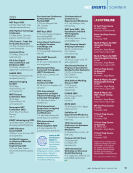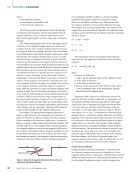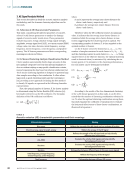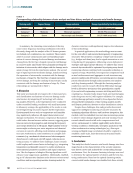ABSTR ACT
To investigate tensile damage characteristics and
mechanisms in depth, this study employed acoustic
emission (AE) technology for real-time monitoring
of the concrete axial tension process and integrated
k-means clustering analysis to achieve self-organized
classification of the collected AE signals. By applying
correlation analysis of AE feature parameters and
the coefficient of variation to characterize data
dispersion, the optimal clustering results were
selected. These results, combined with temporal
analysis dividing the damage stages, collectively
achieved the classification of concrete damage
severity. Finally, through analyzing the underlying
AE feature parameters within the clustering results,
an effective interpretation of the concrete axial
tension damage mechanisms at different severity
levels was accomplished. This research method
provides new insights into nondestructive testing
and structural health monitoring of concrete
structures, offering potential value for engineering
applications. In the future, the method can be
extended to more complex structural systems, and
its applicability in long-term service environments
can be explored to advance the development of
intelligent monitoring and prediction technologies.
KEYWORDS: concrete, axial tension damage, acoustic
emission, k-means clustering analysis, correlation analysis,
coefficient of variation
1. Introduction
For a long time, concrete materials have been widely used in
construction projects, and a systematic study of the tensile
properties, which play a decisive role in the safety of concrete
structures, is of significant importance [1]. Acoustic emission
(AE) technology, as a nondestructive testing method with
advantages such as real-time monitoring, high sensitivity, and
comprehensiveness [2, 3, 4], is capable of capturing dynamic
signals from internal microcracks in materials, providing more
comprehensive information on damage evolution. Unlike
localized measurement methods such as strain gauges or dis-
placement sensors, AE can capture dynamic signals gener-
ated during the microscopic cracking processes within mate-
rials, providing more comprehensive damage information.
Compared to techniques such as eddy current and magnetic
particle testing [5, 6], which are limited to detecting conduc-
tive or surface defects, AE can capture the dynamic damage
processes (e.g., crack initiation) through elastic wave signals.
The method is especially suitable for early warning of hidden
defects in nonmetallic materials. Unlike techniques like X-ray
or ultrasound [7], which rely on predefined scanning areas or
directions, AE can cover a wider monitoring range through
sensor placement, making it particularly suitable for complex
structures and dynamic loading scenarios. Therefore, AE
technology enables monitoring of the entire concrete tensile
damage process and captures AE signals containing compre-
hensive damage information [8].
In recent years, the application of AE technology in
concrete damage research has increased. Liu et al. [9] studied
the damage processes and mechanisms of different beams by
analyzing various AE signals during the bending failure process
of concrete beams reinforced with basalt fiber-reinforced
polymer (BFRP). D. Zhang et al. [10] combined AE technology
with time-frequency analysis to reveal the bending damage
process and mechanisms of reinforced concrete beams in
high-temperature saltwater corrosion environments, provid-
ing an important basis for dynamic monitoring of concrete
damage. T. Li et al. [11] used AE and digital image correla-
tion (DIC) techniques to reveal the damage evolution laws of
seawater sea-sand ultra-high-performance concrete (SSUHPC)
under uniaxial compression. Prem et al. [12] identified the
failure mechanisms of concrete specimens using AE parame-
ters obtained from monitoring, proving the effectiveness of AE
NDTTECHPAPER
|
ME
ANALYSIS OF CONCRETE AXIAL TENSILE
DAMAGE DEGREE BASED ON ACOUSTIC
EMISSION SIGNAL CLUSTERING ANALYSIS
WANG YAN‡*, XU GUOXING‡, ZHAO HAITAO‡†, WANG NA‡, SU YIHUI‡, AND GU JIE‡
‡ College of Civil Engineering and Transportation, Hohai University, Nanjing
210024, China
*Corresponding author: drwanghhu@126.com
† Corresponding author: hhuzhaoht@163.com
Materials Evaluation 83 (5): 41–52
https://doi.org/10.32548/2025.me-04487
©2025 American Society for Nondestructive Testing
M AY 2 0 2 5 • M AT E R I A L S E V A L U AT I O N 41
To investigate tensile damage characteristics and
mechanisms in depth, this study employed acoustic
emission (AE) technology for real-time monitoring
of the concrete axial tension process and integrated
k-means clustering analysis to achieve self-organized
classification of the collected AE signals. By applying
correlation analysis of AE feature parameters and
the coefficient of variation to characterize data
dispersion, the optimal clustering results were
selected. These results, combined with temporal
analysis dividing the damage stages, collectively
achieved the classification of concrete damage
severity. Finally, through analyzing the underlying
AE feature parameters within the clustering results,
an effective interpretation of the concrete axial
tension damage mechanisms at different severity
levels was accomplished. This research method
provides new insights into nondestructive testing
and structural health monitoring of concrete
structures, offering potential value for engineering
applications. In the future, the method can be
extended to more complex structural systems, and
its applicability in long-term service environments
can be explored to advance the development of
intelligent monitoring and prediction technologies.
KEYWORDS: concrete, axial tension damage, acoustic
emission, k-means clustering analysis, correlation analysis,
coefficient of variation
1. Introduction
For a long time, concrete materials have been widely used in
construction projects, and a systematic study of the tensile
properties, which play a decisive role in the safety of concrete
structures, is of significant importance [1]. Acoustic emission
(AE) technology, as a nondestructive testing method with
advantages such as real-time monitoring, high sensitivity, and
comprehensiveness [2, 3, 4], is capable of capturing dynamic
signals from internal microcracks in materials, providing more
comprehensive information on damage evolution. Unlike
localized measurement methods such as strain gauges or dis-
placement sensors, AE can capture dynamic signals gener-
ated during the microscopic cracking processes within mate-
rials, providing more comprehensive damage information.
Compared to techniques such as eddy current and magnetic
particle testing [5, 6], which are limited to detecting conduc-
tive or surface defects, AE can capture the dynamic damage
processes (e.g., crack initiation) through elastic wave signals.
The method is especially suitable for early warning of hidden
defects in nonmetallic materials. Unlike techniques like X-ray
or ultrasound [7], which rely on predefined scanning areas or
directions, AE can cover a wider monitoring range through
sensor placement, making it particularly suitable for complex
structures and dynamic loading scenarios. Therefore, AE
technology enables monitoring of the entire concrete tensile
damage process and captures AE signals containing compre-
hensive damage information [8].
In recent years, the application of AE technology in
concrete damage research has increased. Liu et al. [9] studied
the damage processes and mechanisms of different beams by
analyzing various AE signals during the bending failure process
of concrete beams reinforced with basalt fiber-reinforced
polymer (BFRP). D. Zhang et al. [10] combined AE technology
with time-frequency analysis to reveal the bending damage
process and mechanisms of reinforced concrete beams in
high-temperature saltwater corrosion environments, provid-
ing an important basis for dynamic monitoring of concrete
damage. T. Li et al. [11] used AE and digital image correla-
tion (DIC) techniques to reveal the damage evolution laws of
seawater sea-sand ultra-high-performance concrete (SSUHPC)
under uniaxial compression. Prem et al. [12] identified the
failure mechanisms of concrete specimens using AE parame-
ters obtained from monitoring, proving the effectiveness of AE
NDTTECHPAPER
|
ME
ANALYSIS OF CONCRETE AXIAL TENSILE
DAMAGE DEGREE BASED ON ACOUSTIC
EMISSION SIGNAL CLUSTERING ANALYSIS
WANG YAN‡*, XU GUOXING‡, ZHAO HAITAO‡†, WANG NA‡, SU YIHUI‡, AND GU JIE‡
‡ College of Civil Engineering and Transportation, Hohai University, Nanjing
210024, China
*Corresponding author: drwanghhu@126.com
† Corresponding author: hhuzhaoht@163.com
Materials Evaluation 83 (5): 41–52
https://doi.org/10.32548/2025.me-04487
©2025 American Society for Nondestructive Testing
M AY 2 0 2 5 • M AT E R I A L S E V A L U AT I O N 41













































































